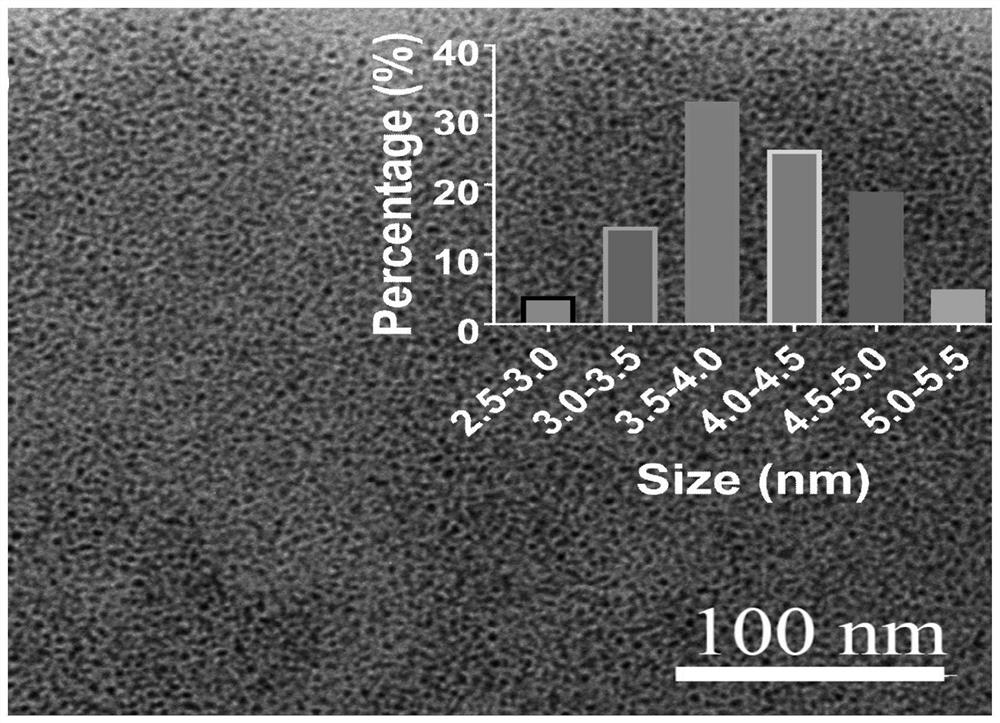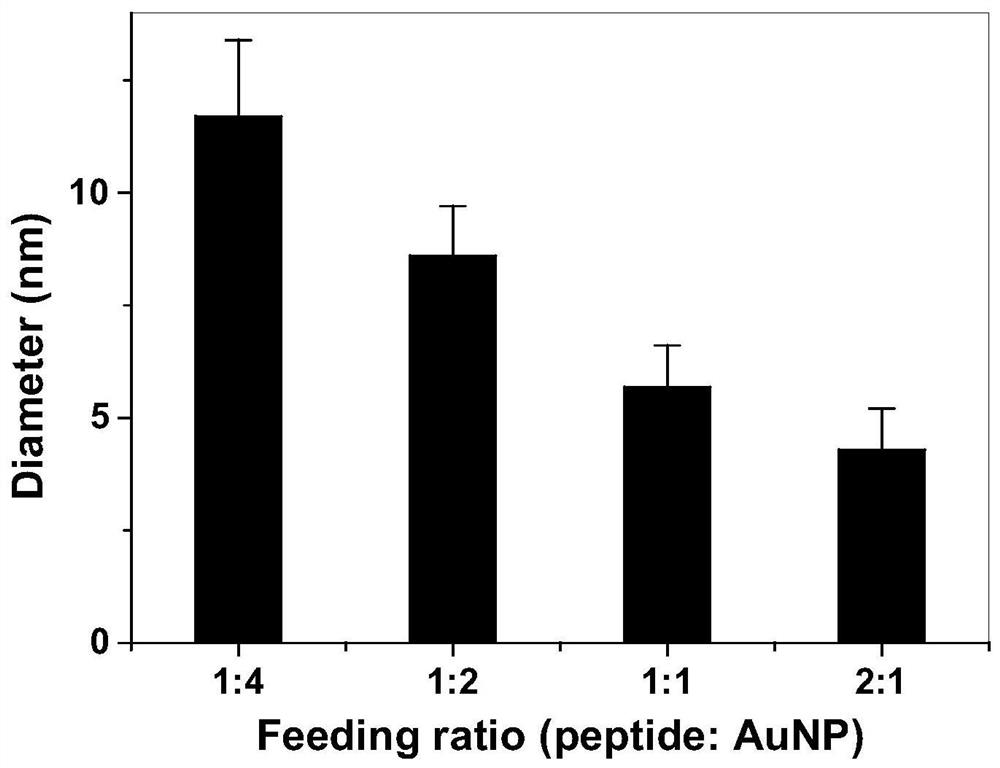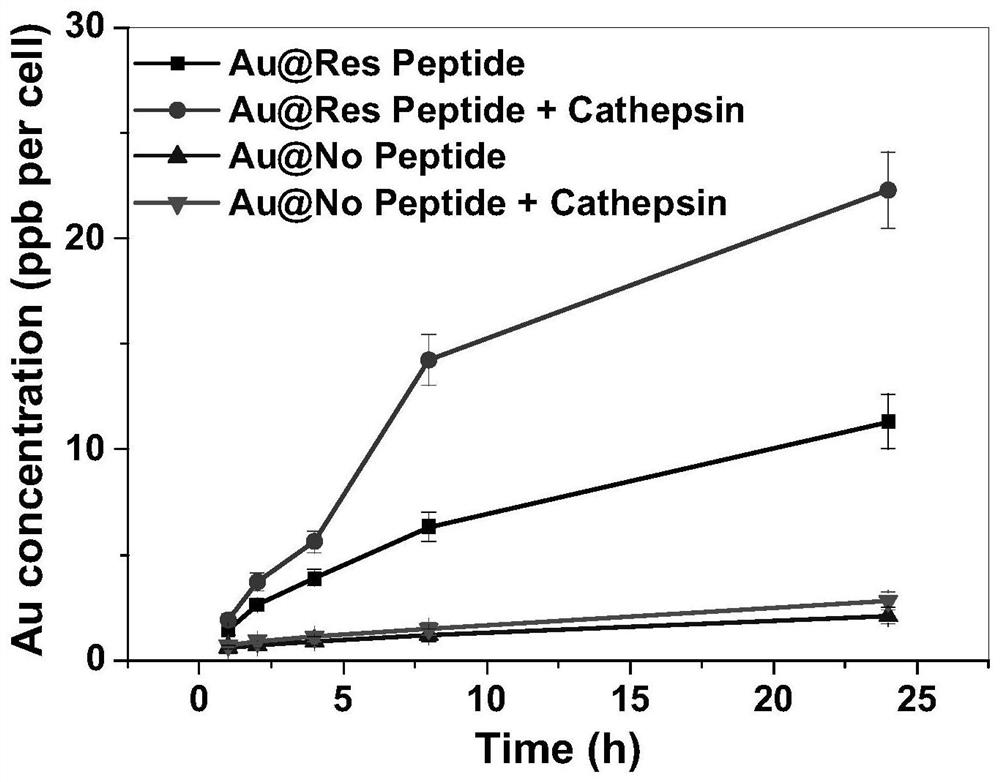Ultrasmall gold nanoparticles for mitochondrial targeting and rapid renal metabolism in tumor cells
A nanoparticle, tumor cell technology, applied in antitumor drugs, wave energy or particle radiation treatment materials, medical preparations with inactive ingredients, etc. To improve the degree of enrichment and residence time, facilitate metabolism, and achieve good biosafety effects
- Summary
- Abstract
- Description
- Claims
- Application Information
AI Technical Summary
Problems solved by technology
Method used
Image
Examples
Embodiment 1
[0043] 1) Add the peptide CCEKEKVFrFKFrFKVGFLGVEKEKEKEKEKEK to 10 mL of chloroauric acid (1 mM) solution, and stir vigorously at room temperature for 15 minutes to make the peptide concentration reach 2 mM. Sodium borohydride was added to bring the concentration to 10 mM. After stirring vigorously at room temperature for 0.5-1 hour, a polypeptide-stabilized ultra-small gold nanoparticle suspension is obtained. Its transmission electron microscope pictures are shown in figure 1 .
[0044] 2) Put 10mL of the gold nanoparticle suspension obtained in step 1) into a dialysis centrifuge tube (molecular weight cut-off 3000Da), centrifuge at 5000 rpm for 10 minutes, and the solution containing excess polypeptide ligand and sodium borohydride will be collected at the bottom of the centrifuge tube, The ultra-small gold nanoparticles obtained by concentration are retained on the upper part of the centrifuge tube.
[0045] 3) The gold nanoparticles (Au@Res Peptide, 100 μg / mL) obtained ...
Embodiment 2
[0049] Same as Example 1, the difference lies in step 1): Add polypeptide CCEKEKVFrFKFrFKVGFLGVEKEKEKEKEKEK to 10mL of chloroauric acid (1mM) solution, stir vigorously at room temperature for 15 minutes, so that the concentration of the polypeptide reaches 0.25, 0.5, 1.0, 2.0mM respectively. Sodium borohydride was added to bring the concentration to 10 mM. After stirring vigorously at room temperature for 0.5-1 hour, the peptide-stabilized ultra-small gold nanoparticle suspension prepared under different raw material feeding ratios is obtained. The results of the relationship between the size of gold nanoparticles and the proportion of raw materials can be found in figure 2 . As the ratio of polypeptide to chloroauric acid gradually increased, the particle size of the obtained nano-gold gradually decreased. It can be seen that to obtain gold nanoparticles with a particle size below 5.5nm, the molar ratio of polypeptide to chloroauric acid needs to be 1-2:1.
Embodiment 3
[0051] Same as Example 1, the difference lies in step 1): in 10mL of chloroauric acid (1mM) solution, add different polypeptides respectively:
[0052] (1) CCEKEKVFrFKFrFKVGFLGVEKEKEKEKEKEK;
[0053] (2) CEKEKVFrFKFrFKVGFLGVEKEKEKEKEKEK;
[0054] (3) CVFrFKFrFKVGFLGVEKEKEKEKEKEK;
[0055] (4) CEKVFrFKFrFKVGFLGVEKEKEKEKEKEK.
[0056] Vigorously stir at room temperature for 15 minutes to make the peptide concentration reach 2.0 mM. Sodium borohydride was added to bring the concentration to 10 mM. After stirring vigorously at room temperature for 0.5-1 hour, a stable ultra-small gold nanoparticle suspension of different polypeptides is obtained. The results of the relationship between the size of gold nanoparticles and peptides can be found in Figure 6 . It can be seen that all four kinds of polypeptides can obtain gold nanoparticles with a particle size below 5.5nm.
PUM
| Property | Measurement | Unit |
|---|---|---|
| diameter | aaaaa | aaaaa |
| particle diameter | aaaaa | aaaaa |
Abstract
Description
Claims
Application Information
 Login to View More
Login to View More - R&D
- Intellectual Property
- Life Sciences
- Materials
- Tech Scout
- Unparalleled Data Quality
- Higher Quality Content
- 60% Fewer Hallucinations
Browse by: Latest US Patents, China's latest patents, Technical Efficacy Thesaurus, Application Domain, Technology Topic, Popular Technical Reports.
© 2025 PatSnap. All rights reserved.Legal|Privacy policy|Modern Slavery Act Transparency Statement|Sitemap|About US| Contact US: help@patsnap.com



